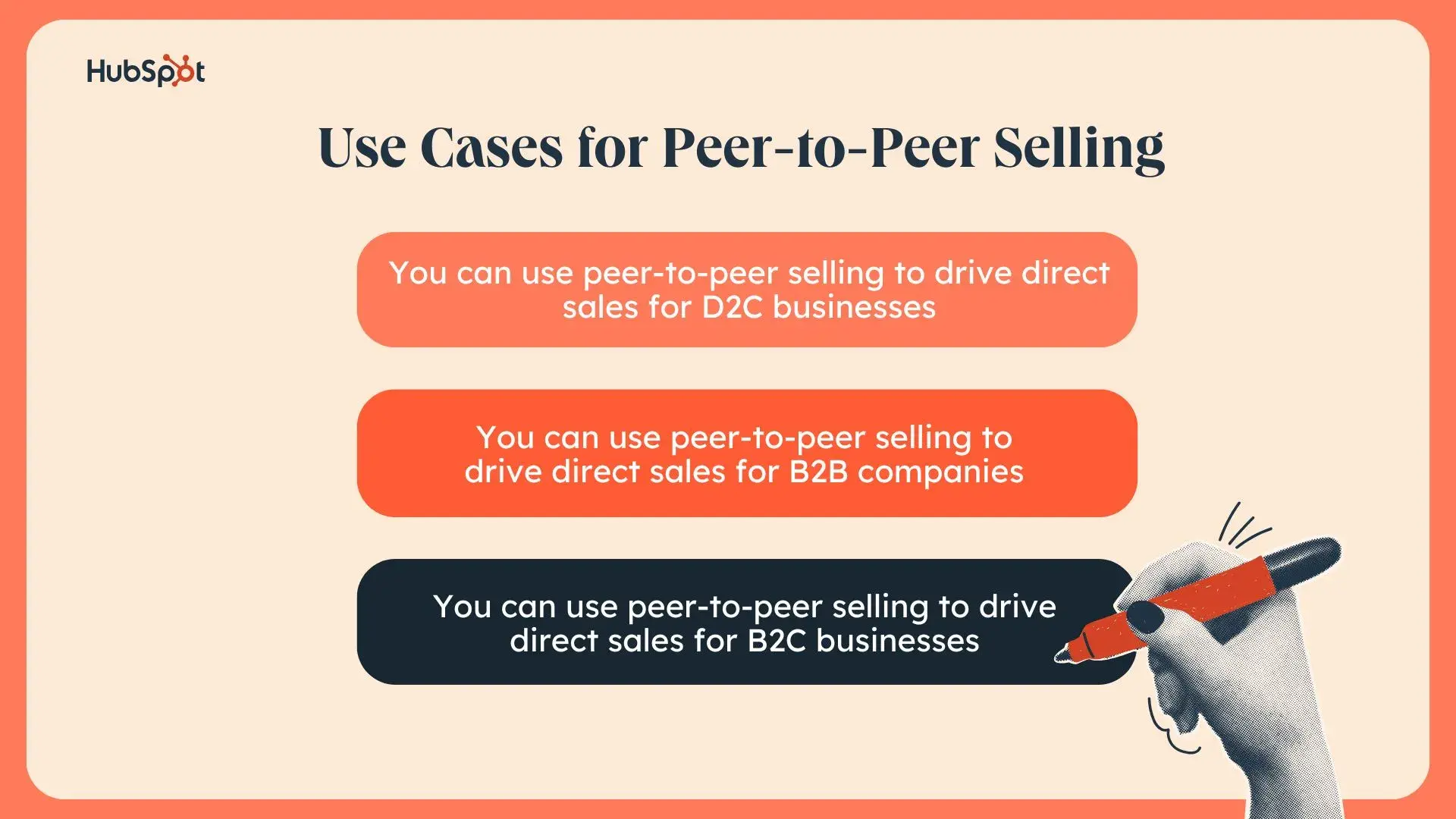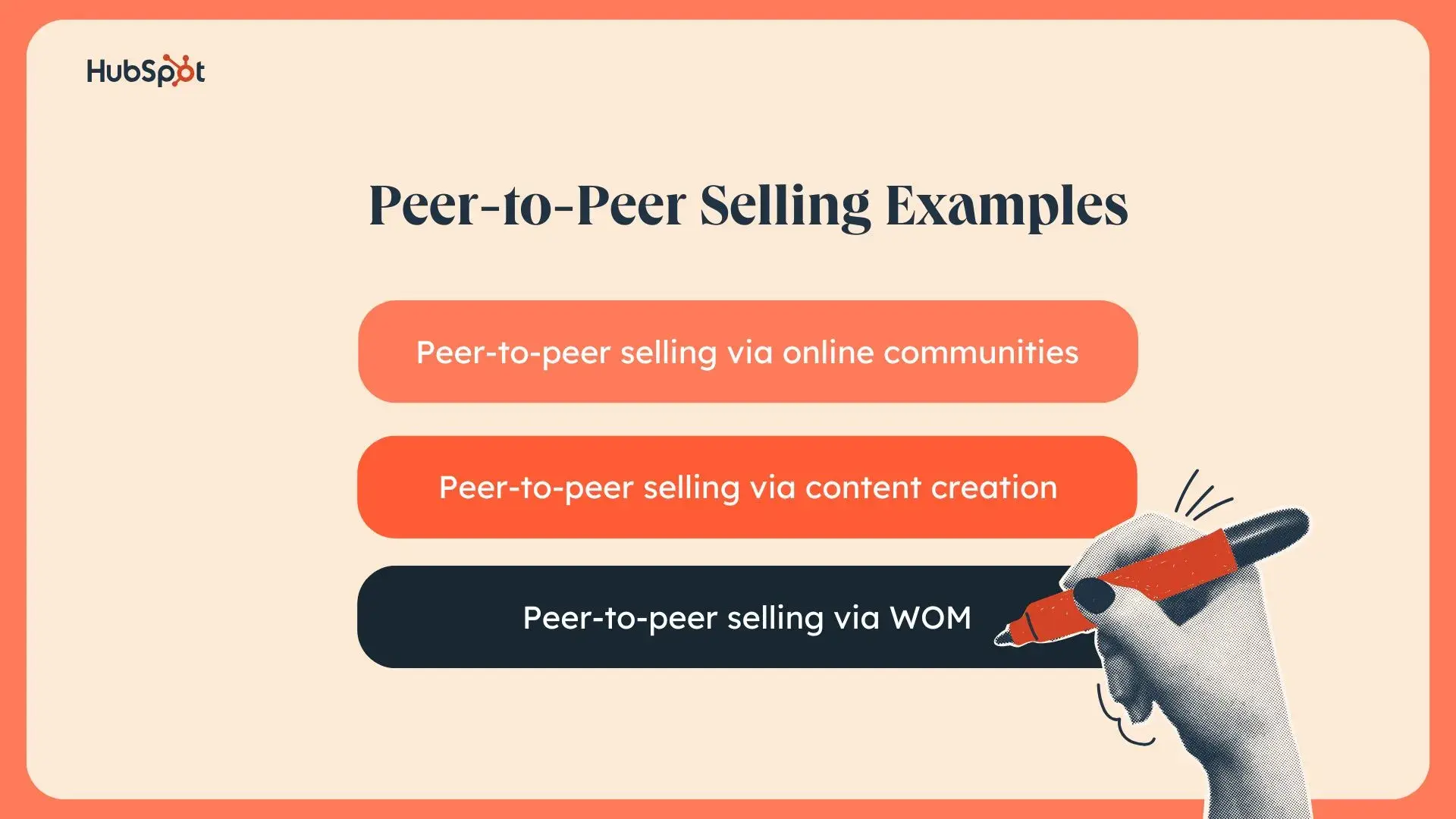Imagine this: you’re telling a friend about that new thing you just bought, and before you know it, they’re buying it, too. And while this may seem like no biggie, that, my dear reader, wasn’t just a random exchange of information. What you experienced is the magic of peer-to-peer selling, live and in-action.

When you share your honest excitement about a product or service, it resonates on a personal level. The peer-to-peer selling approach works brilliantly in this way. It flips traditional sales by focusing on what cold calls and cookie-cutter selling methodologies won’t: trust and relatability.
At its core, peer-to-peer selling is about connecting with people. In this article, I’ll explain how peer-to-peer selling functions, what you can do to transcend the feeling of “pawning off” a sales pitch to your prospects, and some habits you can adopt to turn casual conversations into meaningful opportunities.
Table of Contents:
- What is peer-to-peer selling?
- Statistics You Should Know About Before Trying P2P Selling
- How Peer-to-Peer Selling Works
- Why is peer-to-peer selling important?
- Why Peer-to-Peer Selling is Worth the Effort
What is peer-to-peer selling?
Peer-to-peer (P2P) selling is a sales approach in which individuals directly recommend and sell products or services to others, leveraging personal relationships and trust. It focuses on authentic, one-on-one interactions that feel more like helpful advice than traditional sales tactics.
What is peer-to-peer selling?
Peer-to-peer (P2P) selling is a sales approach in which individuals directly recommend and sell products or services to others, leveraging personal relationships and trust. It focuses on authentic, one-on-one interactions that feel more like helpful advice than traditional sales tactics.
A successful P2P selling strategy can be a massive asset to any business looking to expand its reach and influence — often without a substantial financial commitment.
When peer-to-peer selling is done right, customers can be as effective a sales resource as any other. Still, its success is genuinely contingent upon what other people are sharing and how they share their experiences and enthusiasm. Where they share this information matters, too.
Sales is, in large part, the process of cultivating and leveraging your prospects’ trust. However, every sales effort is rooted in establishing credibility; that premise makes peer-to-peer selling as essential and effective as possible.
In the past year alone, P2P selling has been all the rage. In the next section, I’ll review statistics you should know to understand why this approach has taken the spotlight, how it’s reshaping the sales landscape, and why it’s more than just a passing trend.
Statistics You Should Know About Before Trying P2P Selling
P2P selling has gotten quite popular within the last year; like I mentioned above, its success is reliant on what, where, and how real-life customers are sharing their perceptions of what they buy. Recently, customers have been looking high and low for solid testimonies about all the things they’ve seen advertisements about — from technology to pet food — to get the real scoop.
Don’t believe me? Take a look at these eye-opening statistics from :

Free Sales Plan Template
Outline your company's sales strategy in one simple, coherent sales plan.
- Target Market
- Prospecting Strategy
- Budget
- Goals
Download Free
All fields are required.

You're all set!
Click this link to access this resource at any time.
- 96% of prospects do their own research before talking to a human sales rep
- 71% of prospects prefer to just do their own research instead of talking to a rep
- 82% of sales pros say building relationships and connecting with people is both the most important part of selling
- 72% of sales reps use social media to find new prospects, with Facebook (38%), Instagram (31%), and YouTube (29%) being the most used channels
What does all of this tell us? Here’s my guess:
- Customers are more independent than ever
- Prospects are prioritizing their own research to learn more about brands, companies, products, and services
- Prospects want unfiltered, no BS information about what they’re considering investing in
In the next section, I’ll share a more detailed breakdown of how peer-to-peer selling works, what industries you can expect to see it in, and examples of its different forms.
How Peer-to-Peer Selling Works
In short, peer-to-peer selling works like suggesting your favorite local spot on Reddit, but with a bit more structure — and a potential commission.
P2P selling relies on legitimate connections to share products and/or services with folks who have yet to try them. This approach opts for swapping non-organic marketing and sales teams in suits for individuals who step up as brand ambassadors, sharing their experiences and enthusiasm directly with their network. It’s kind of like word-of-mouth (WOM) marketing, just not as confined to one-on-one verbal exchanges.
Peer-to-peer selling works like a charm, but it’s still relegated to specific industries and, thus, is used differently across those industries. Check out a few use cases for P2P selling below:
Use Cases for Peer-to-Peer Selling

1. You can use peer-to-peer selling to drive direct sales for D2C businesses.
Peer-to-peer selling thrives in the direct-to-consumer (D2C) space because D2C selling is all about personal connections from the moment a customer begins their buyer’s journey. Whether it’s a customer’s favorite beauty influencer recommending skincare or a popular foodie raving about their go-to organic snack brands, P2P quickly turns curious customers into loyal ones.
People trust people, and in the case of D2C products (like makeup, eyeglasses, or footwear), folks want buzz that comes from someone relatable.
2. You can use peer-to-peer selling to drive direct sales for B2B companies.
B2B doesn’t have to be boring. My tip for making it interesting? Try out the P2P strategy.
Peer-to-peer selling can be a great tool for changing the narrative that the B2B sales process has to be dry and transactional. Plus, it does have the potential to be super effective in the big business world, especially considering that most B2B folks are likely looking for more interpersonal sales interactions.
After all, decision-makers are people, too — they tend to trust input from those they know rather than a salesperson. For example, a CFO is more likely to adopt new work management software if a fellow executive shares their success story, or a high-level manager might choose a new benefits supplier after hearing about a seamless experience from a friend within their network.
3. You can use peer-to-peer selling to drive direct sales for B2C businesses.
Peer-to-peer selling goes a long way in the B2C world. When customers are looking for their next personal investment (regardless of what it is), they often rely on endorsements from people they can have full faith in.
Customers are more likely to research a business, engage with it, and, most importantly, purchase from it when they get honest, relatable feedback from individuals who’ve actually interacted with B2C businesses (i.e., restaurants and cafes, e-commerce stores, fitness centers, etc.) and their offerings.
For example, imagine you’re on the hunt for a new gym. An ad might tell you the gym has the latest equipment, but hearing your friend gush about their motivating trainers, clean facilities, and fun group classes? That’s what will seal the deal. These firsthand stories create an immediate sense of trust and credibility that no billboard or online ad can replicate.
Peer-to-peer selling in the B2C space is more than a strategy; it’s a way to humanize the sales process and build lasting customer loyalty.
Peer-to-Peer Selling Examples

1. Peer-to-peer selling via online communities.
The great thing about P2P selling? It can be utilized in and adapted for any digital community space. Now that platforms like Instagram, LinkedIn, and TikTok have developed additional opportunities for connectivity (i.e., broadcast channels, in-platform product linking, live shopping events, etc.), there’s an emphasis on meeting folks where they already spend their time, especially when selling a product or service is involved.
Online communities are hubs for authentic engagement, so salesfolks should naturally integrate into them. Here’s my recommendation for doing so (without it being too obvious): start with poking around comment sections, then ease into formulating relationships with individuals who may be looking for suggestions or assistance in other areas of online communities.
The key is to provide genuine value before ever mentioning what you’re selling — it’s about connection first, everything else comes afterward.
2. Peer-to-peer selling via content creation.
Whether you enjoy being in front of the camera or prefer letting someone else take the spotlight, content creation is one of the best (and low-cost) ways to garner visibility and engagement with your business or brand. Today’s economy values social media influencers who will give them the cold, hard truth about their favorite products, services, even grocery stores.
So, when in doubt about how to get your P2P selling efforts across, lean into sharing whatever feels real. Relatable content wins every time.
3. Peer-to-peer selling via WOM.
The classic word-of-mouth (WOM) approach is arguably the OG of peer-to-peer selling. While it might not come with the bells and whistles of modern technology, it’s as effective as ever. For customers, it carries weight when someone they trust — like a coworker, friend, or family member — raves about a product or service.
WOM works because it’s organic, personal, and inherently credible. In a world of ads, a simple “you’ve got to try this” from someone you trust can make all the difference.
The beauty of P2P selling is that it doesn’t require you to be a sales expert. In fact, the more relatable and approachable you are, the better. Again, remember, my dear reader: with the P2P approach, “selling” takes a backseat; it’s all about proving your merit first.
Why is peer-to-peer selling important?
Peer-to-peer selling has been around forever, and there’s a reason for that. Here’s why:

Free Sales Plan Template
Outline your company's sales strategy in one simple, coherent sales plan.
- Target Market
- Prospecting Strategy
- Budget
- Goals
Download Free
All fields are required.

You're all set!
Click this link to access this resource at any time.
- People tend to believe real customers more than businesses. They’re more likely to tolerate what their friends, family, broader personal network, and similar consumers have to say.
- In most cases, a prospect’s peers have less of an agenda or incentive to speak highly of a company than the company itself. In turn, they come across as more objective and trustworthy.
- The more customers you can get to personally and enthusiastically vouch for your product, the more prospects you can reach. That personal endorsement carries immense weight because it’s rooted in real-life experience.
Ultimately, the P2P selling methodology may require a bit more work on your end, but, when you really think about all the long-term loyalty it encourages, it pays off.
Peer-to-Peer Selling Tips
If you’re thinking about trying out P2P selling, here are my recommendations for getting started:
1. Get active on social media (if you aren’t already).
Successful P2P selling is a byproduct of making your brand seem approachable, engaging, and authentic. One of the better ways to get there is to be active on social media. And you can take a lot of roads to make that happen.
Consistently posting high-quality content to relevant spaces — like a before-and-after LinkedIn post or a process-focused Instagram Reel — that review your company’s product or service can help you establish yourself as an authority in your space and connect with potential customers.
2. Keep an eye out for online reviews; don’t be afraid to respond to them, either.
In a similar vein to the point above, you can help cultivate a receptive, authentic reputation online for your company by responding and constructively reacting to online reviews — whether they’re good or … less than stellar.
If successful P2P selling requires nothing else, it absolutely demands a compassionate, human element. If you want to create and project that element sincerely, show prospects how well you can take (and act on) customer feedback. Addressing your online reviews with patience, enthusiasm, and empathy is one of the more straightforward ways of building assurance and validity.
3. Customer visibility is an important currency, be sure to use it to your advantage.
As I mentioned earlier, trust is the basis for any effective P2P selling efforts. And consumers are much more inclined to trust their fellow consumers — who act without incentive or agenda — than they are to take your business on its word.
If you have satisfied customers, do what you can to ask for and platform their positive experiences with your offering or company itself to their networks. By doing this, you'll easily generate interest from prospects who rely on their peers for cues on brand integrity.
4. Online forums hold lots of honest perspectives, go try to find them.
If you want to present a personable, helpful image that can serve as the basis for effective P2P sales efforts, you’re going to do some internet sleuthing. This is where scouring digital forums (i.e., Reddit, comment sections, Discord, Medium.com) will come in handy.
If you can join these coveted online spaces, don’t poke around unbeknownst. Contribute to the discussion. Make your company known as a valuable resource for answering potential customers’ questions and concerns. Establish yourself as a reliable, interested authority online, and you’ll put yourself in an excellent position to further bolster your P2P selling efforts.
Why Peer-to-Peer Selling is Worth the Effort
At the end of the day, peer-to-peer selling is about framing your business as a trusted resource that solves more than it sells. In a lot of ways, you need to cast your company as a consumer peer in itself. That means taking the time to actively engage with your prospects, help allay their needs and concerns, and demonstrate that your business is worth talking up.
If you’re hoping to use the P2P selling strategy for some serious sales growth this year, I say go for it, but be prepared to show up consistently and make every effort to foster genuine relationships with potential prospects. It’s all about playing the long game and letting your happy customers do the heavy lifting for you.

Free Sales Plan Template
Outline your company's sales strategy in one simple, coherent sales plan.
- Target Market
- Prospecting Strategy
- Budget
- Goals
Download Free
All fields are required.

You're all set!
Click this link to access this resource at any time.
![Question-Based Selling: What It Is And A Step-by-Step Guide On How To Make It Work For You [+ Pro Tips For Sales Reps]](https://knowledge.hubspot.com/hubfs/question-based-selling-1-20250121-1004908.webp)


![Complex Selling: What It Is, How It Works, and How You Can Do It Well [+ Tips I Learned From A Top-Performing Enterprise Sales Pro]](https://www.hubspot.com/hubfs/Copy%20of%20Copy%20of%20ai%20sales%20%20%2816%29.webp)
![I Learned How Sales Champions Drive Deals Forward — Here’s What You Should Know [+ Recent Data]](https://www.hubspot.com/hubfs/sales-champion-1-20250110-9355712-1.webp)
![Everything I Know About Gap Selling: What It Is And How To Make It Work For Your Sales Strategy [+ Examples]](https://knowledge.hubspot.com/hubfs/gap-selling-1-20241219-8406832.webp)



